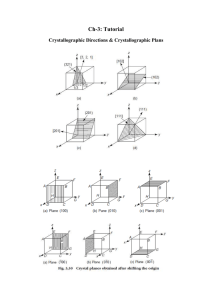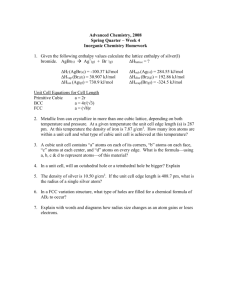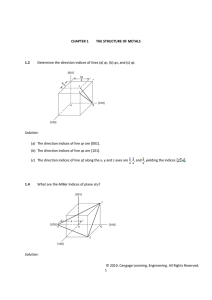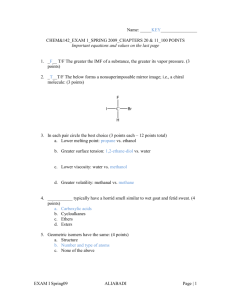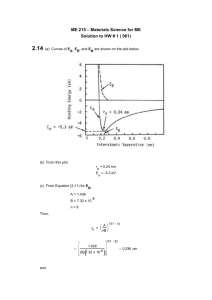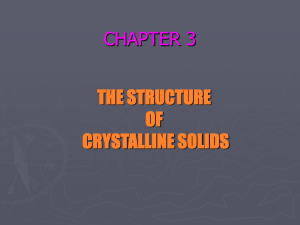SampleTest 1 - Department of Materials Science and Engineering
advertisement
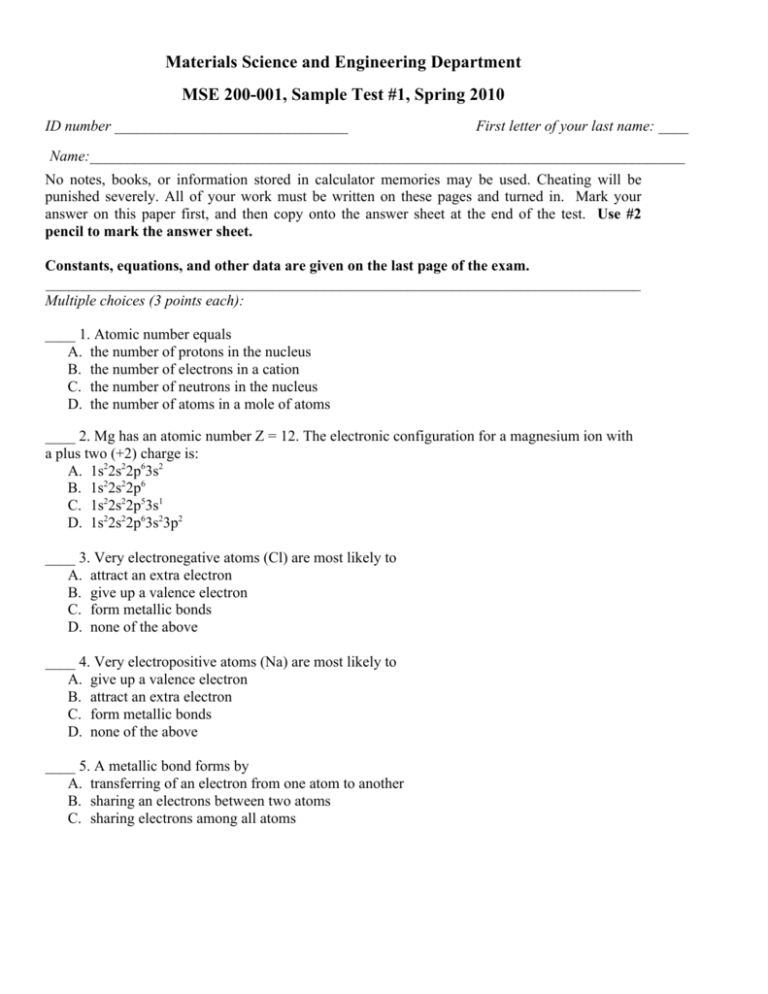
Materials Science and Engineering Department MSE 200-001, Sample Test #1, Spring 2010 ID number _______________________________ First letter of your last name: ____ Name:_______________________________________________________________________________ No notes, books, or information stored in calculator memories may be used. Cheating will be punished severely. All of your work must be written on these pages and turned in. Mark your answer on this paper first, and then copy onto the answer sheet at the end of the test. Use #2 pencil to mark the answer sheet. Constants, equations, and other data are given on the last page of the exam. _______________________________________________________________________________ Multiple choices (3 points each): ____ 1. Atomic number equals A. the number of protons in the nucleus B. the number of electrons in a cation C. the number of neutrons in the nucleus D. the number of atoms in a mole of atoms ____ 2. Mg has an atomic number Z = 12. The electronic configuration for a magnesium ion with a plus two (+2) charge is: A. 1s22s22p63s2 B. 1s22s22p6 C. 1s22s22p53s1 D. 1s22s22p63s23p2 ____ 3. Very electronegative atoms (Cl) are most likely to A. attract an extra electron B. give up a valence electron C. form metallic bonds D. none of the above ____ 4. Very electropositive atoms (Na) are most likely to A. give up a valence electron B. attract an extra electron C. form metallic bonds D. none of the above ____ 5. A metallic bond forms by A. transferring of an electron from one atom to another B. sharing an electrons between two atoms C. sharing electrons among all atoms ____ 6. Nitrogen has 5 electrons in its outer orbital. Two nitrogen atoms form an N2 molecule by sharing A. 1 electron (forming 1 covalent bond) B. 2 electrons (forming 2 covalent bonds) C. 3 electrons (forming 3 covalent bonds) D. 4 electrons (forming 4 covalent bonds) For the following three problems: 100 g of solder contains 52 wt% tin (Sn) and 48 wt% lead (Pb). The atomic weight of Sn is 118.7 g/mol, and the atomic weight of Pb is 207.2 g/mol. ____ 7. No. of mole of Sn in the solder is: A. 0.843 mol B. 0.559 mol C. 0.4381 mol ____ 8. No. of mole of Pb in the solder is: A. 0.1333 mol B. 1.2317 mol C. 0.2317 mol ____ 9. The atomic percentages of Sn and Pb in the solder are: A. 65.4 and 34.6 at%, respectively B. 34.6 and 65.4 at%, respectively C. 20 and 80 at%, respectively. ____ 10. The size of a unit cell is described by: A. a lattice constant B. a unit cell diagonal. C. a crystallographic vector D. (hkl) Miller indices ____ 11. In a bcc structure, the lattice constant, a, and the atom radius, R, have the following relationship: A. a = 4R / 2 B. a = 4R / 3 C. a = 2R ____ 12. In a fcc structure, the lattice constant, a, and the atom radius, R, have the following relationship: A. a = 4R / 3 B. a = 2R C. a = 4R / 2 ____ 13. The number of atoms in a unit cell of bcc, fcc and hcp metals are A. 4, 2, 6, respectively B. 6, 4, 2, respectively C. 2, 4, 6, respectively D. none of the above ____ 14. The body centered cubic (BCC) and face-centered cubic (FCC) lattices A. have different packing factors B. both contain close-packed planes C. have the same stacking sequences of the close-packed planes D. all of the above ____ 15. The body diagonal of a BCC unit cell is A. the lattice parameter (a) B. equal to the diameter of two atoms C. not a close packed direction D. none of the above ____ 16. [111] direction is A. parallel to (111) plane B. perpendicular to (111) plane ____ 17. [101] direction is on A. (101) plane B. (111) plane C. (1 1 1) plane D. ( 1 11) plane ____ 18. The direction indices for the crystallographic direction indicated by the vector is A. B. C. D. [111] [100] [110] [101] ____ 19. The direction indices for the crystallographic direction indicated by the vector is A. B. C. D. [101] [111] [110] [ 1 01] ____ 20. The miller indices for the shaded plane is A. B. C. D. ( 1 01) ( 2 1 3) (203) (213) ____ 21. The miller indices for the shaded plane is A. B. C. D. ( 1 01) ( 2 1 3) (3 1 2) (2 1 3) For the following 2 problems: The lattice parameter of copper is 0.362 nm. The atomic weight of copper is 63.54 g/mole. Copper forms an fcc structure. Answer the following questions. ____ 22. Volume of the unit cell of copper in cubic centimeters is A. 0.047x10-21 B. 0.047x10-27 C. 0.13x10-12 ____ 23. Density of copper in g/cm3 is A. 897.9 B. 8.98 C. 0.11 ____ 24. A cube plane has the following axial intercepts: a=1/2, b= 1/3, c= 1. The miller indices of this plane is A. (231) B. (326) C. (132) ____ 25. In interstitial solid solution, the solute atoms occupy A. interstitial sites B. normal solvent atom sites C. changes the crystal structure of solvent D. vacancy sites ____ 26. The figure on the right is a(n) A. B. C. D. vacancy vacancy and interstitial atom edge dislocation screw dislocation ____ 27. Grain boundaries are: A. point defects B. line defects C. two dimensional defects D. none of the above ____ 28. Interstitials are: A. point defects B. line defects C. two dimensional defects D. none of the above ____ 29. Two types of dislocations are: A. B. C. D. interstitial and subsitutional FCC and BCC Edge and screw None of the above ____ 30. Substitutional diffusion A. requires existence of vacancies B. becomes faster with increasing temperature C. needs to overcome an energy barrier D. all of the above ____ 31. The substitutional diffusion of Ni (solute) in Cu (solvent) A. is a thermally activated process (improves with temperature) B. increases in rate with increasing temperature C. requires the presence of vacancies D. all of the above ____ 32. With increasing melting point, the activation energy for diffusion generally becomes A. higher B. lower C. same ____ 33. The reason that vacancies are always present in the lattice is A. they are equilibrium defects B. crystals are not perfect C. they are easy to form D. there is an activation energy for their formation ____ 34. For the diffusion of carbon in iron, Q=142 kJ/mol and Do=2x10-5 m2/s. The diffusion coefficient of carbon in iron (D in m2/s) at 927oC is: A. B. C. D. 1.32 x 10-11 m2/s 3.2 x 10-12 m2/s 0.63 x 10-10 m2/s 0.5 x 10-14 m2/S ____ 35. For pure Cu at 500°C, the activation energy for the formation of a vacancy is 0.90 eV. The Boltzmann’s constant is k = 8.62 x 10-5 eV/K. Cv= exp(-Ev/kT) The vacancy concentration is: A. 1.36 x 10-6 B. 1.36 x 106 C. 1.36 x 10-12 Constants and Equations for Exam #1 NA = 6.02 x 1023 mole-1 k = 8.62 x 10-5 eV/atom- 1GPa = 103MPa = 109Pa=109N/m2 109 nm = 1 m ao = 1 J/m2 = 1 N/m K = C +273 Volume of sphere = 102 cm = 1 m 4R 3 J = D R = 8.31 J/mol-K ao = 4R = 2R 2 2 4 3 R 3 Nv = Ne Qv / kT Q D = Do exp d RT dC dx Error function: z 0.20 0.25 0.30 0.35 0.40 0.45 0.50 erf(z) 0.2227 0.2763 0.3286 0.3794 0.4284 0.4755 0.5205 z 0.55 0.60 0.65 0.70 0.75 0.80 0.85 erf(z) 0.5633 0.6039 0.6420 0.6778 0.7712 0.7421 0.7707 z 0.90 0.95 1.00 1.10 1.20 1.30 1.40 erf(z) 0.7970 0.8209 0.8427 0.8802 0.9103 0.9340 0.9523 z 1.50 1.60 1.70 1.80 1.90 2.00 2.20 erf(z) 0.9661 0.9763 0.9838 0.9891 0.9928 0.9953 0.9981 Answer Key: 1A 2B 3A 4A 5C 6C 7C 8C 9A 10A 11B 12 C 13C 14A 15B 16B 17D 18D 19B 20C 21C 22A 23 B 24A 25A 26A 27C 28A 29C 30D 31D 32A 33 A 34 A 35A
